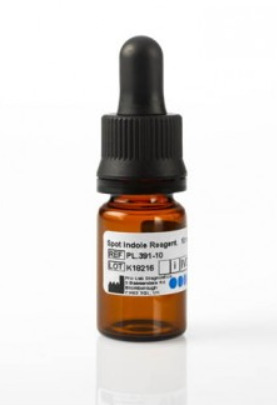Indole Test
Last reviewed by Editorial Team on February 27th, 2019.
An indole test is a procedure performed to find out the ability of a microorganism to split amino acid tryptophan to form an indole.
The presence of indole is checked with the help of Kovac’s or Ehrlich’s reagent. The indole test is not a new procedure. As a matter of fact, it has been used since 1889 to differentiate between E. coli and Enterobacter aerogenes.
Up until now, the indole test is a standard procedure to detect indole positive E. coli and indole negative Enterobacter and Klebsiella. (1, 2)

Image 1: The image shows the result of indole test tube method.
Picture Source: i.ytimg.com

Picture 2: The test tube on the left is indole test negative while the test tube on the right is indole positive.
Photo Source: www.vetbact.org
Why indole test is done?
The indole test is done to check for the microorganism’s ability to degrade the amino acid tryptophan and produce indole.
It is a part of the IMViC test; which consists of a series of test that checks and identify Enterobacteriaceae family. (1, 2)
Indole test reagent
There are various reagents used for indole testing. They are the following:
- Indole spot reagent – It contains p-Dimethylaminocinnamaldehyde (DMACA), deionized water, and hydrochlorid acid.
- Indole kovac’s reagent – It contains p-Dimethylaminobenzaldehyde, hydrochlorid acid, and amyl alcohol. (2, 3)

Photo 3: A Kovac’s reagent is one of the reagentsfff used in indole test.
Image Source: www.pro-lab.co.uk

Image 4: A spot reagent used for indole test.
Picture Source: www.keyscientific.com
Indole Testing Method

Picture 5: An indole test tube method with Klebsiella pneumonia as the medium.
Photo Source: i.pinimg.com
#1 – Tube Method
It identifies weak indole producing microorganisms.
Procedure
- Inoculate tryptophan broth using a broth culture. You can also emulsify isolated colony of the microorganism in the tryptophan broth.
- Incubate for at least 24 to 28 hours in ambient air at a temperature of 37 degrees Celsius.
- Add the Kovac’s reagent (0.5 ml) to the broth culture. (3, 4)
Result
- The result is positive if the color of the medium turns pink after adding the reagent.
- The result is negative if there is no noticeable change in the color of the medium after adding the appropriate reagent. (3, 4)
#2 – Spot Indole Method

Photo 6: The image shows the result of the spot indole test.
Image Source: microbenotes.com
It identifies rapid indole producing microorganisms.
Procedure
- Saturate the filter paper using 1% paradimethylaminocinnamaldehyde reagent.
- With the use of a wooden stick, remove a small portion of the colony of microorganism to be tested from the agar surface and gently rub the sample on the saturated filter paper. (4, 5)
Result
- The result is positive if the color of the medium changes into blue within 30 seconds.
- If the color is slightly pink or no changes in the color at all, then the test is negative. (4, 5)
What are examples of indole positive organisms?
- E. coli
- M. morganii
- P. vulgaris
- Providenica
- Klebsiella oxytoca
- Citrobacter Koseri
- Aeromonas hydrophila
- Bacillus alvei
- Aeromonas punctate
- Haemophilus influenza (6)
- Edwardsiella sp
- Flavobacterium sp
- Plesiomonas shigelloides
- Pasteurella pneumotropica
- Pasteurella multocida
What are examples of indole test negative organisms?
- Klebsiella pneumonia
- Citrobacter freundii
- Proteus mirabilis
- Actinobacillus spp
- Alcaligenes sp
- Aeromonas salmonicida
- Enterobacter sp
- Bordetella sp
- Haemophilus sp
- Pasteurella ureae (7)
- Salmonella sp
- Pseudomonas sp
- Neisseria sp
- Mannheimia haemolytica
Variations
In some laboratories, the indole test procedure can be performed using multi-test agar. These include the following:
- Sulfide indole motility – It is used to check for indole production and at the same time determines the motility and sulfide producing ability of the isolate.
- Motility indole ornithine – It tests for indole production, motility, as well as ornithine decarboxylase of the organism.
- Motility indole urease – It tests the organism’s ability to produce indole, motility, and the urease producing ability. (7, 8, 9)
Are there any limitations?
- Although the indole test is helpful in identifying and differentiating gram positive and gram negative organisms additional testing needs to be done to completely identify the organism.
- Of the two indole testing methods, the tube method is the more sensitive one. Hence, the steps should be carefully followed and the test should be interpreted in a timely manner.
- If you are going to use the spot method, you can use either the spot test reagent or the Kovacs indole reagent, but know that the latter is less sensitive than the former.
- If you are testing anaerobic bacteria, you should not use the Kovacs indole reagent.
- A medium that contains glucose should not be used for indole testing because it forms an acid end product which can significantly reduce the production of indole.
- You should not use Mueller Hinton Agar because it destroys tryptophan during acid hydrolysis of casein. (3, 9, 10)
Indole test is a procedure used to detect the ability of the organisms to convert tryptophan into indole. It is one of the four standard tests of the IMViC series.
References:
- https://en.wikipedia.org/wiki/Indole_test
- https://microbeonline.com/indole-test-principle-procedure-results/
- https://microbiologyinfo.com/indole-test-principle-reagents-procedure-result-interpretation-and-limitations/
- http://www.asmscience.org/content/education/protocol/protocol.3202
- https://catalog.hardydiagnostics.com/cp_prod/Content/hugo/IndoleTestRgnts.htm
- http://www.biologypractical.com/indole-test-objective-principle-procedure-and-result/
- https://laboratoryinfo.com/indole-test/
- http://www.wikiwand.com/en/Indole_test
- http://shs-manual.ucsc.edu/policy/indole-test
- https://microbenotes.com/indole-test-objective-principle-media-procedure-and-results/
